Consider the following puzzle:
A cell is either marked or unmarked. Numbers along the right and bottom side of the puzzle denote the total sum for a certain row or column. Cells contribute (if marked) to the sum in its row and column: a cell in position (i,j) contributes i to the column sum and j to the row sum. For example, in the first row in the picture above, the 1st, 2nd and 5th cell are marked. These contribute 1 + 2 + 5 to the row sum (thus totalling 8), and 1 each to their column sum.
I have a solver in ECLiPSe CLP for this puzzle and I am tyring to write a custom heuristic for it.
The easiest cells to start with, I think, are those for which the column and row hint are as low as possible. In general, the lower N is, the fewer possibilities exist to write N as a sum of natural numbers between 1 and N. In the context of this puzzle it means the cell with the lowest column hint + row hint has lowest odds of being wrong, so less backtracking.
In the implementation I have a NxN array that represents the board, and two lists of size N that represent the hints. (The numbers to the side and on the bottom.)
I see two options:
Write a custom selection predicate for search/6. However, if I understand correctly, I can only give it 2 parameters. There's no way to calculate the row + column sum for a given variable then, because I need to be able to pass it to the predicate. I need 4 parameters.
Ignore search/6 and write an own labelling method. That's how I have it right now, see the code below.
It takes the board (the NxN array containing all decision variables), both lists of hints and returns a list containing all variables, now sorted according to their row + column sum.
However, this possibly cannot get any more cumbersome, as you can see. To be able to sort, I need to attach the sum to each variable, but in order to do that, I first need to convert it to a term that also contains the coordinates of said variable, so that I convert back to the variable as soon as sorting is done...
lowest_hints_first(Board,RowArr,ColArr,Out) :-
dim(Board,[N,N]),
dim(OutBoard,[N,N]),
( multifor([I,J],[1,1],[N,N]), foreach(Term,Terms), param(RowArr,ColArr) do
RowHint is ColArr[I],
ColHint is RowArr[J],
TotalSum is RowHint + ColHint,
Term = field(I,J,TotalSum)
),
sort(3,<,Terms,SortedTerms), % Sort based on TotalSum
terms_to_vars(SortedTerms,Board,Out), % Convert fields back to vars...
( foreach(Var,Out) do
indomain(Var,max)
).
terms_to_vars([],_,[]).
terms_to_vars([field(I,J,TotalSum)|RestTerms],Vars,[Out|RestOut]) :-
terms_to_vars(RestTerms,Vars,RestOut),
Out is Vars[I,J].
In the end this heuristic is barely faster than input_order. I suspect its due to the awful way it's implemented. Any ideas on how to do it better? Or is my feeling that this heuristic should be a huge improvement incorrect?
